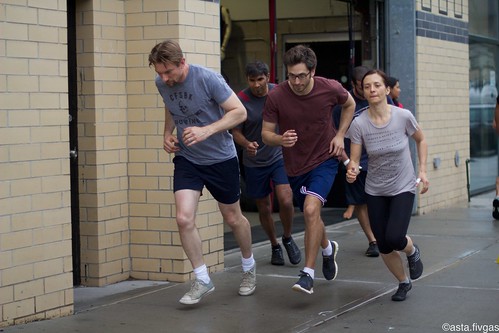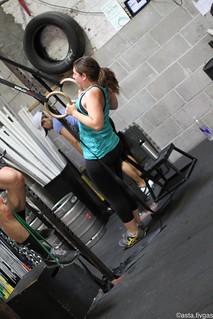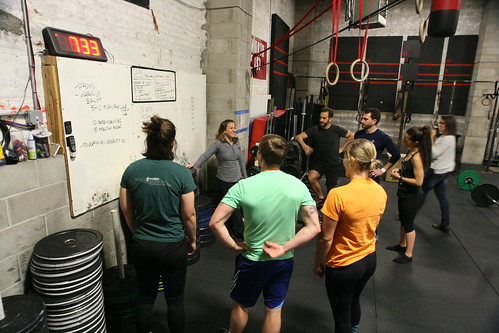The Benefits of Introductory Programs at Affiliates
 Monday, January 13, 2014 at 12:00AM
Monday, January 13, 2014 at 12:00AM 
As we mentioned in our article “Screening Policies for New and Transfer Athletes,” a fairly standard entry point for newcomers into CrossFit affiliates is an introductory course, often named something like Foundations, Elements, or On Ramp. In my opinion, a thorough, well-executed foundations program is one of the best ways an affiliate filters new members into their existing group class programs. In this week's article, I'll talk about why I think our Foundations program is so important, describe our philosophical approach to it, discuss some other options, and provide the syllabus for our most current curriculum.
I started CFSBK in a park in Brooklyn—back when very few people knew what CrossFit was—and only five months in I started requiring Foundations courses for new or interested members. Three of those initial few months involved only a handful of people, training two days a week. But at the time I implemented Foundations in early 2008, I'd developed a consistent following of about 10-20 people attending the small number of group classes I offered. Even with such a small group, it was obvious to me that having to review the most elemental features of every exercise as new people showed up was a disservice to my most loyal members. Additionally, it created a potential "wild card" situation for every class, given that someone I’d never met or seen move could show up to any of my group classes.
CFSBK has since run well over 300 Foundations cycles and countless private sessions over the last six years. While the basic template and class structure have evolved (and continue to evolve), the intent of the program remains the same.
 Starting with the most basic movements.The Purpose of Foundations
Starting with the most basic movements.The Purpose of Foundations
As I wrote previously, our Foundations program does exactly what its name implies: creates a solid foundation for new members so they can enter group classes with a basic technical understanding of our movements and exercise philosophy. Obviously this involves teaching people how to properly perform our most commonly used exercises in a safe and effective manner. But beyond mechanics, it's worth noting that teaching a movement at this level should also include teaching ancillary protocol, such as...
- How athletes will see the movement programmed in group classes
- What weight they should start at with various lifts
- What considerations can be made for movement restrictions, weaknesses, etc.
- Basic protocol around the movement, including how to rack and unrack barbells, the basic settings on the rowing machine are, how to store the plyo boxes,
etc.
Taking the time to review the How's and Why's around movements helps your new members make intelligent training decisions when they find themselves in their first several weeks of group classes.
Perhaps more importantly, instilling good general training habits is critical at this new, unformed point when people haven't yet had the opportunity to go rogue on you, trying to lift All the Weights on Day One. CFSBK accomplishes this with by delivering a couple short lectures (specifically about programming and training habits), and requiring Foundations members to read this article. Foundations also gives you the space and time to work consistently with a small group and really get to know people's basic movement patterns—and provide nuanced, specific advice to each participant right at the beginning of their training.
Learning or not learning the basic athletic wisdom of starting slow, prioritizing movement quality, and training intelligently can drastically influence someone's CrossFit experience. Take the time to explain the movements and smart approaches to them in the beginning, and you'll see that your members are more coachable and successful in the long run.
 Foundations is where you also take the time to learn how to safely use the equipment."But I'm brand new and can't afford creating barriers for anyone coming to my gym!"
Foundations is where you also take the time to learn how to safely use the equipment."But I'm brand new and can't afford creating barriers for anyone coming to my gym!"
As mentioned above, I only had a few consistent members when I started requiring Foundations. Even then, it was immediately obvious to me that having a basic filtration method both made my job much easier and helped the business. Foundations increased our revenue and led to overall greater retention of new members. If someone was motivated enough to sign up for a series of classes at my gym, it became more likely that they'd stick around afterwards and feel invested in joining group classes.
Foundations also allows you to isolate and encourage your most motivated and committed new prospective members—while still offering a wider level of coaching to your existing group class members. An open policy for joining your group classes invites tons of people "window shopping" for fitness programs, and these are not the kinds of people you want to be spending your valuable time coaching. Given the technical and intense nature of what we do in group classes, there is also a larger chance your Average Joe new to CrossFit is going to get scared off attempting "Isabel" or max effort deadlifts on their Day One at the gym.
In regards to the financial benefits, let’s just do some simple math. At CFSBK, we charge $250 for a six-class Foundations cycle, which we cap at four to six people, depending on the time of day. That's a guaranteed $1,000-$1,500 per cycle you run and sell out (we sell out about 95% of every cycle we offer). Take that further, say you’re conservatively running five cycles a month at different times of day, and that puts your Foundations revenue at $5,000 to $7,500 per month. Without Foundations, you'd have to cross your fingers and hope that someone dropping in at a $25 rate shows up to 10 classes before they would break even with a Foundations student. Of course, you might be able to initially make more upfront cash with a steady stream of people dropping in, but as mentioned above, these are not the kinds of coaching situations I would want to be in on a day-to-day basis. A solid Foundations program ultimately is a win/win for your affiliate and your members.
Other Potential Methods for Introducing New Members
I've heard of a few other methods for filtering people into CrossFit affiliates ranging from not having any intro course to requiring one-on-one private sessions for all new members. Here are some of the reasons we've decided not to go any of those routes:
 Learning good training habits starts on Day One. Mandatory One-on-One Foundations
Learning good training habits starts on Day One. Mandatory One-on-One Foundations
I think this is the most well-intentioned alternative to a Foundations program, but it has a few significant flaws. First, in order to keep the price point low enough for someone who can't afford ongoing private training (or the equivalent of say, six classes), you'll probably be limited to one to three classes, which in my opinion, is nowhere near enough time to give all the movements and protocols their due diligence. Additionally, I feel strongly that the attention a decent coach can offer four to six people is not that different or less effective than working one-on-one, especially if you get to work with the group for longer periods of time. With a Foundations program, the pay barrier is lower and the gym's revenue for that hour ends up being higher, so leveraging your time also makes more sense financially. Furthermore, even a well-staffed gym won't have enough coaches to accommodate every single person who wants to join your gym with one-on-one sessions.
I should point out that we do always offer the option for one-on-one and semi-private Foundations sessions for people who request it. This is especially important to offer people with significant orthopedic issues or medical considerations, and some people simply feel more comfortable in this individual, private setting, have scheduling limitations, or are only interesting in personal training.
 Six consecutive classes is a great way for your new members to learn the flow of the gym and how to work with each other. It also increases the chances friendships will be made by the end of it.Ongoing Leveled Classes
Six consecutive classes is a great way for your new members to learn the flow of the gym and how to work with each other. It also increases the chances friendships will be made by the end of it.Ongoing Leveled Classes
Special ongoing classes that new people can drop into (before eventually rotating into the next level of group classes) is the least specific version of an introductory method to affiliate membership, because there are so many ways it can be implemented. I'll address a couple features that give me pause about the method in general. First, you end up dedicating an hour and valuable gym real estate to a potentially unknown amount of people—maybe three people show up, maybe 15. When we run Foundations concurrent with group classes, we always know exactly how much equipment and space we'll need.
Additionally, an open enrollment environment precludes a systematic progression of basic to more advanced movements. In open enrollment, one person might be showing up on the day you're going to break down snatch technique, without ever learning more basic movements such as squats and presses. You again fall into the trap of having to review elements of basic movements in every class if you don't want to leave people behind. Finally, depending on how you structure the payments, you could be catering to a bunch of people shopping for the next quick-fix fitness fad—not people ultimately interested in serious training.
Teaser Class
In our last newsletter (sign up on the top right!), I spoke a little bit about the Sunday teaser classes we offer—which are the most effective way we’ve found to deal with the window-shopper category. For an hour and a half most Sunday afternoons, these classes serve as a basic introduction to CrossFit and include a WOD. The class creates a space in our gym where we can funnel people who aren’t sure they want to pony-up a bunch of time and money for Foundations yet. This is a great way to open your doors to the public in a controlled class setting. In a future article, I’ll write more extensively about our Teaser class.
Class Syllabus Notes
Our Foundations program is a six-class, two or three-week cycle, consisting of hour-and-15 minute sessions. The basic programming for each class is linked in the first paragraph of this article; if you like it please use it! In future articles, I'll break down each class with more detail and context to better explain how the classes are actually run.
____________________
What is your affiliate’s approach to Foundations? What are some of the benefits you've experienced from it?

Reader Comments (3)
Hi David! It's Scott from Bare Hands CrossFit in St. Louis. I dropped in for a week or so in late December and we chatted for a bit up in your mobility gym about OnRamp and such. My mom is back in Brooklyn to visit, so she'll be back in this week I'm sure. She absolutely loves your gym. So thank you for treating her so kindly.
I'm excited to read your follow-up articles to this one with more details about each class session. We do an 8 class (2 x week) OnRamp with the invitation to join Saturday group classes with scaled WODs to get a feel for the gym when it's really hopping.
As a Supple Leopard fan, what I really like about your itinerary is the early introduction of bracing. I have found that giving your athletes an action plan while approaching a barbell, or kettlebell, pull-up bar, (air squat even) etc. has really made my new athletes feel more comfortable and safe while handling weight. I think this is a big deal for most who have never been around a barbell and find it intimidating and don't want to look silly while performing a lift.
What I really have found is beneficial, is the OnRamp really seems to set even my most ambitious athletes into the mindset of building strength and developing technique slowly and not trying to beat the world in the first week of regular class. I think it shows that your gym is really interested in proper fundamentals and creates an atmosphere of learning and open discussion.
I can't wait to read how you run your intro classes in more detail. Keep up the great work and say hi to my mom, Linda, for me!
Thanks!
Scott
Great post David! I love what you're doing here. At my box, CrossFit Analog we actually require any athlete who is new to CrossFit to complete a full set of foundations classes before they are eligible for any regular class, even drop ins or punch card programs. In addition to ensuring that they're moving safely through all the movements, we ant every person who works out with us to be a true part of our community, not just a stranger who drops in for a WOD every now and then!
Scott,
Thanks for reaching out. It was great talking shop with you while you were here and we love having your mom in town. We've found that teaching the bracing strategy and how to achieve pure hip flexion are two of the most important and basic skills you can teach people as they're themes you see in almost every movement we teach. Glad you noticed it!
Jesse,
Sounds like you've got a great thing going! Please keep us updated and in the loop on other things you're doing at your affiliate. Thanks!